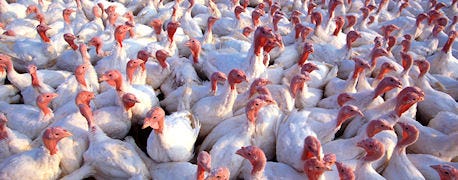April 21, 2015

The H5N2 avian influenza has been confirmed in commercial turkey flock in Kingsbury County, S.D., and Dickey County, N.D.
The Kingsbury County, S.D., flock is the second to come down with the disease in the South Dakota. The flock of 34,000 turkeys is located within the Central flyway where this strain of avian influenza has previously been identified.
Both farms have been quarantined and the flocks will be depopulatedt o prevent the spread of the disease. Domestic birds in a 6-mile control zone around the affected farms are being monitored and tested; and movement is being restricted to help prevent the spread of virus Birds from the flock will not enter the food system.

Two more turkey flocks in North Dakota and South Dakota are infected with H5N2 avian influenza. Photo: USDA ARS
"North Dakota has about five active commercial turkey farms and raises roughly 1 million turkeys annually," says Agriculture Commissioner Doug Goehring. "We are doing everything we can to help prevent future outbreaks to protect the livelihood of our turkey farmers."
The Center for Disease Control considers the risk to people from these HPAI H5 infections in wild birds, backyard flocks and commercial poultry, to be low. No human infections with the virus have been detected at this time.
Avian influenza is caused by an influenza type A virus which can infect poultry (such as chickens, turkeys, pheasants, quail, domestic ducks, geese and guinea fowl) and is carried by free flying waterfowl such as ducks, geese and shorebirds. AI viruses are classified by a combination of two groups of proteins: hemagglutinin or "H" proteins, of which there are 16 (H1–H16), and neuraminidase or "N" proteins, of which there are 9 (N1–N9). Many different combinations of "H" and "N" proteins are possible. Each combination is considered a different subtype, and can be further broken down into different strains. AI viruses are further classified by their pathogenicity (low or high) — the ability of a particular virus strain to produce disease in domestic chickens.
The HPAI H5N8 virus originated in Asia and spread rapidly along wild bird migratory pathways during 2014, including the Pacific flyway. In the Pacific flyway, the HPAI H5N8 virus has mixed with North American avian influenza viruses, creating new mixed-origin viruses. These mixed-origin viruses contain the Asian-origin H5 part of the virus, which is highly pathogenic to poultry. The N parts of these viruses came from North American low pathogenic avian influenza viruses.
USDA has identified two mixed-origin viruses in the Pacific Flyway: the HPAI H5N2 virus and new HPAI H5N1 virus. The new HPAI H5N1 virus is not the same virus as the HPAI H5N1 virus found in Asia, Europe and Africa that has caused some human illness. Only the HPAI H5N2 virus has been detected in the Pacific, Mississippi and Central Flyways.
Source: USDA
You May Also Like




